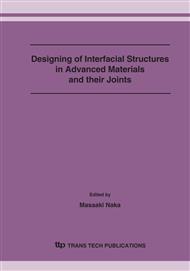p.147
p.155
p.161
p.167
p.173
p.179
p.185
p.189
p.195
Fabrication and Wettability Test of Silicon Nitrides with Ordered Protrusions
Abstract:
Silicon nitrides are often used as ladles, stalks, heater element protection tubes, etc., in the metal casting industry. A low wettability for molten metals is required for these purposes since wetting by molten metals leads to adhesion of solidified metals, which causes several problems. Surface structure is known to affect wettability. Thus, the present study attempts to fabricate silicon nitrides with controlled surface structures. Silicon nitrides, whose surfaces were covered with ordered hemispherical protrusions, were fabricated by the slip-casting technique. The cast bodies were sintered, and subjected to wettability tests using molten metals. For comparison, silicon nitrides with as-sintered and polished surfaces were also prepared. The surface with protrusions exhibited a lower contact angle compared to the as-sintered and polished surfaces. The contact angle depended on the diameter of the hemisphere; it was the largest at a diameter of 0.3 mm.
Info:
Periodical:
Pages:
173-178
Citation:
Online since:
September 2007
Authors:
Keywords:
Price:
Сopyright:
© 2007 Trans Tech Publications Ltd. All Rights Reserved
Share:
Citation:


